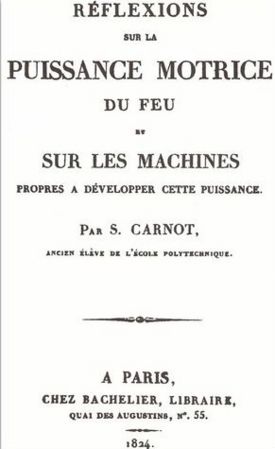Carnot cycle
A Carnot cycle is a reversible cycle in the state space of a thermodynamic system, consisting of two isotherms (paths of constant temperature) and two isentropes (paths of constant entropy). A heat engine that undergoes periodic Carnot cycles is known as a Carnot engine; it converts heat into work. A Carnot engine is an idealization of real engines, in actual practice it does not exist.
History
In the early 1820s Sadi Carnot, studying the efficiency of steam engines, conceived a virtual, idealized, version of a steam engine as a vehicle for his Gedankenexperimente (thought experiments) in which he mimicked the work of actual steam engines. He reported the results of his studies in a booklet (see the adjacent title page) published in 1824.[1] By means of his engine Carnot tried to find answers to questions as: Would it be advantageous to use steam at high pressures, and if so, would there be a limit at which further raising of pressure ceases to be advantageous? How important is the working medium, is steam the best substance, or could any other liquids and their vapors, or air, perform as well?
Conceptually, a steam engine is a very simple devise; its rudimentary form consists of a piston that cyclically moves in and out a cylinder, driven by expanding steam. The steam flows from the boiler (hot) to the condenser (cold). Inspired by this construction, Carnot devised an engine, basically a fluid-filled cylinder with a piston, that is alternately exchanging heat with a hot and a cold reservoir. When in contact with the hot reservoir, the engine receives heat and performs work on its surroundings—this stage is comparable to the steam engine piston moving out of the cylinder and performing work. When the cylinder is in contact with the cold reservoir, the surroundings perform work on the engine, i.e., compress the substance inside the cylinder, and the resulting heat is given off to the cold reservoir—this stage is comparable with the piston of a steam engine driven back into the cylinder. While this alternating process is going on, the thermodynamic state of a fixed amount of fluid inside the engine changes periodically, that is, the substance goes through thermodynamic cycles, after each cycle the thermodynamic state is exactly equal to the initial state (has same temperature, pressure, volume, &helllip;). Carnot proved that it is irrelevant for his abstract engine what the actually working substance is, it may be water, steam, an ideal gas, or anything else.
At the time of writing his booklet, Carnot saw heat as a fluid, called "caloric", that "falls" from high to low temperature. He thought that the "motive power" that the caloric received from the hot reservoir was converted into work; the caloric itself was conserved and flowed back into the cold reservoir. Carnot was inspired by the equivalence of his engine with a water wheel that, in principle, can extract work from the potential energy ("motive power") of water that is initially higher than the water wheel. Of course, in a water wheel the water itself does not disappear, it is conserved. If "caloric" is simply equated to "heat"—a form of energy—and since motive power is also a form of energy, Carnot's ideas were contrary to conservation of energy (the first law of thermodynamics). But, the first law had not yet been formulated during Carnot's life time. Carnot's ideas came very close to the formulation of the second law of thermodynamics, especially in the form given by Thomson.
In the 1850s, R. Clausius and W. Thomson discovered the first law and realized that the Carnot engine converts only part of the heat into work. A sizable amount of remaining heat is given off to the cold reservoir. Nevertheless, Carnot's ideas proved to be very useful to Clausius and Thomson when they postulated the second law of thermodynamics. For this reason it is could be stated that the second law was discovered before the first law.
Clausius and Thomson further proved that in the idealized case that the thermodynamic process in the Carnot engine occurs reversibly (which in practice never happens) that it has maximum efficiency, engines based on irreversible cycles or other cycles than the Carnot cycle (the subject of this article), have lesser efficiency (yield less work with the same amount of heat input) than the Carnot cycle.
Technical discussion
In Figure 1 a Carnot cycle is shown. By definition it is reversible (quasi-static) and consists of the "hot" isotherm 2-3, the "cold" isotherm 1-4 and the adiabatics (isentropes) 1-2 and 3-4.
(To be continued)
- ↑ Reflexions on the Motive Power of Fire, translated and edited by R. Fox, Manchester University Press, (1986) Google books


